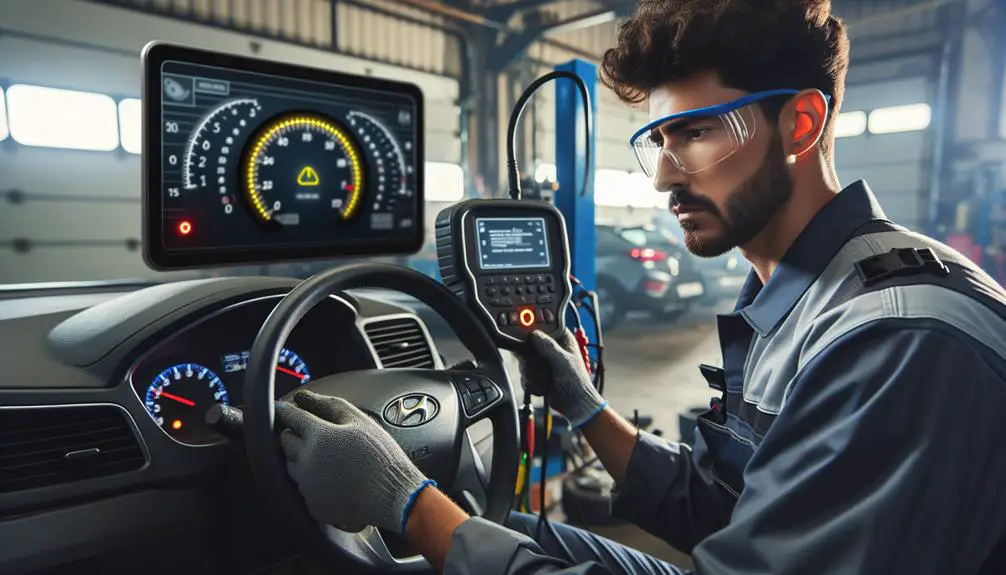This guide will explore Hyundai’s TPMS (Tire Pressure Monitoring System) issues, including why warning lights appear and how to fix them.
From simple battery changes to complex sensor issues, we’ll cover the common reasons for TPMS alerts, like weather changes or sensor replacements.
You’ll learn how to tackle these problems, ensuring your car’s safety and extending your tires’ life.
Common Hyundai TPMS Problems and Their Symptoms
You might encounter a range of issues with your Hyundai’s Tire Pressure Monitoring System (TPMS), including electrical failures, broken accelerometers, and low battery power.
Blocked pressure ports or improper handling during wheel or tire changes can also lead to problems. Recognizing these symptoms early can help you address them before they escalate.
1. Electrical Failure
Hyundai’s TPMS may have electrical issues causing the warning light to activate even if tire pressures are correct. This could be due to short circuits or wiring problems.
Don’t ignore the light; it could indicate bigger problems. It’s important to have it checked by a professional to find the exact issue.
Keeping the TPMS in good condition is crucial for safety and the vehicle’s health.
2. Broken Accelerometer
A broken accelerometer in your Hyundai’s TPMS sensor can cause wrong tire pressure readings, making the warning light stay on. This might make you think there’s a tire problem, but the real issue is with the sensor.
It’s important to notice this early to avoid unnecessary tire work. When the accelerometer doesn’t work, it can’t measure tire movement and pressure correctly, sending wrong information to your car’s system.
It’s best to fix this quickly by seeing a professional. They’ll identify and fix the problem, ensuring your TPMS works well, keeping you informed and safe while driving.
3. Low TPMS Battery Power
Addressing a low TPMS battery is crucial because it affects your Hyundai’s ability to monitor tire pressure. The TPMS sensor battery can run out, reducing its effectiveness.
A flashing TPMS light on the dashboard indicates a low battery. This is a serious warning that the battery needs replacement. Ignoring it can lead to undetected tire pressure problems, risking safety.
Replace the TPMS battery promptly when you see the flashing light.
4. Blocked Pressure Port
If the TPMS warning light on your Hyundai is on, it may mean the sensor’s pressure port is blocked by dirt, debris, or road salt. This blockage stops the sensor from sending accurate tire pressure information to the car’s monitoring system, making it hard to know if tire pressure is too low or too high.
This can be unsafe and lead to tire wear, less fuel efficiency, or a tire blowout. It’s important to fix this issue quickly by getting the TPMS and the blocked pressure port checked by a professional.
5. Inappropriate Handling
Improper handling of Hyundai wheels or tires during service can harm TPMS sensors, causing wrong readings or system issues. It’s important to know this mistake can happen easily.
Damaged TPMS sensors can’t accurately monitor tire pressure, affecting safety and vehicle performance. Handling errors can result in false alerts or no alert when tire pressure is low.
To prevent problems, ensure any wheel or tire service on your Hyundai is performed by professionals who know how to protect the TPMS sensors.
6. Sensor Issues
Hyundai TPMS sensor issues can happen due to impacts during tire changes or when the battery runs out, typically after three years. During tire services, sensors might be damaged. This damage mightn’t be immediately noticeable but can cause TPMS malfunctions later.
Additionally, sensor batteries are designed to last around three years. After this period, the dead batteries can prevent the sensors from working, stopping updates on tire pressure.
7. Warning Light Indicators
When your Hyundai’s TPMS (Tire Pressure Monitoring System) warning light turns on, it means there’s a possible issue. This could be something simple like tires needing more air, or it could be a more complicated problem like an electrical fault or a blockage.
It’s important to pay attention to this light. A steady light usually means a less urgent issue, while a flashing light suggests something more serious. Don’t try to guess what’s wrong. Instead, use the correct tools or get help from a professional to find out the exact problem.
Quickly dealing with TPMS warnings is important for your safety while driving.
8. Warranty and Liability Claims
Hyundai’s warranty might cover TPMS (Tire Pressure Monitoring System) issues, so dealers should fix any problems after service. If you have warning lights or sensor issues, check if they’re covered by the warranty to avoid paying yourself.
Use TPMS diagnostic tools to identify the problem clearly when making a warranty or liability claim. Dealers are responsible for TPMS working correctly after services like tire changes or alignments. If their service causes TPMS issues, they must fix it.
Make sure you don’t pay for issues that the warranty or dealer should cover.
How to Reset Your Hyundai TPMS

Step 1:
Check the pressure of all your tires, including the spare, to ensure they’re inflated to the recommended levels. These values can be found in your owner’s manual or on a sticker inside the driver’s side door jamb. It’s important to correct any tire pressure discrepancies as they might be the reason your TPMS light is on.
Step 2:
Turn the ignition key to the ‘ON’ position, but don’t start the engine. This is to ensure that the vehicle’s electrical system is active for the reset process.
Step 3:
Locate the TPMS reset button, which is usually found under the steering wheel. Press and hold this button until the TPMS light on your dashboard blinks three times, then release the button. This blinking indicates that the recalibration process has started.
Step 4:
After initiating the recalibration, start your car’s engine and let it run for approximately 20 minutes. This running period is crucial for the system to recalibrate properly. If possible, drive at speeds above 15 mph during this time, as movement may be necessary for some vehicles’ TPMS recalibration.
Step 5:
Observe the TPMS light. If it turns off, you have successfully reset your Hyundai’s TPMS. If the light remains on, double-check the tire pressures to ensure they’re correctly inflated according to the manufacturer’s specifications and repeat the reset procedure if necessary.
When to consult a professional for a TPMS reset

If your TPMS light stays on after you try to reset it, see a professional. This could mean there are bigger problems. The TPMS is important for safety because it checks tire pressure. Not fixing it can lead to tire problems.
If the light doesn’t turn off after resetting, there might be a technical issue or the TPMS battery could be low. You need special tools and knowledge to fix these problems.
Experts have the tools to check the TPMS sensors and find out what’s wrong, like a failing sensor or a blocked pressure port.
Seeing a professional helps make sure the TPMS is fixed correctly. Doing it wrong can cause more problems. They’ve the right tools and know-how.
If your car is under warranty, a professional can help with your claim by providing proof of the issue. It’s better to ask for professional help when you’re not sure what to do.
Troubleshooting: Is Your Hyundai TPMS Light On?

Check tire pressure, consider sensor age, seek professional help if needed.
If your Hyundai’s TPMS light is on, first ensure all tires are correctly inflated according to your manual.
If the light persists, it could be due to the age of the TPMS sensors, as their batteries last 5 to 10 years.
If adjusting tire pressure and considering sensor age don’t resolve the issue, professional assistance is necessary for safety and to address potential problems like faulty sensors or a broken accelerometer.
Hyundai TPMS Relearn Procedure

Hyundai vehicles require a TPMS relearn procedure after tire services or sensor replacement, which can be done DIY with a specific tool or through professional assistance.
For a DIY approach, after verifying tire pressure and sensor condition, use a Hyundai-compatible TPMS relearn tool. With the vehicle on and in park, activate each tire’s sensor following the tool’s guidelines. Successful completion resets the system and extinguishes the TPMS light.
If this process seems complex or unsuccessful, professional service is the next step. Hyundai dealers or certified mechanics have the necessary diagnostic equipment to efficiently conduct the relearn process and address any other TPMS-related issues.
The choice between DIY and professional help hinges on personal comfort with vehicle maintenance and the intricacies of the vehicle’s TPMS system.
While DIY might be cost-effective, professional services offer thoroughness and can prevent potential problems, representing a valuable investment for reliability.
The Impact of Weather on Your Hyundai’s TPMS

You might’ve noticed your Hyundai’s TPMS warning light flashing more frequently with the change of seasons. Temperature fluctuations can significantly impact your tire pressure and the accuracy of TPMS readings.
It’s essential to adjust your tire pressure to maintain optimal performance throughout the year.
How temperature changes affect tire pressure and TPMS readings
Temperature shifts affect Hyundai’s TPMS and tire pressure.
Temperature changes cause tire pressure to fluctuate. Cold weather decreases tire pressure, often triggering the TPMS warning light due to air contraction. Warm temperatures increase pressure due to air expansion.
These variations impact vehicle handling and fuel efficiency. The TPMS light serves as a reminder to check tire pressure regularly.
Tips for maintaining optimal tire pressure throughout the seasons
To keep your Hyundai’s tire pressure right and make the TPMS work best, you need to change it with the weather. Cold air makes tire pressure go down, and hot air can make it too high. This can affect how your car drives, its gas use, and how long tires last. Here’s what to do:
- Check tire pressure every month: This helps you spot big changes in pressure early, so your car keeps running well.
- Follow the car maker’s advice for adjusting pressure: Changing pressure with the seasons keeps tires from getting too full or too empty.
- Pay attention to TPMS warnings: Fix tire pressure problems fast when the TPMS tells you.
Replacing Hyundai TPMS Sensors: What You Need to Know

When you notice your Hyundai’s TPMS light staying on, it might be time to consider replacing the sensors. Understanding the signs for replacement and the associated costs can save you from unexpected tire problems down the road.
We’ll guide you through what you need to know about selecting and installing new TPMS sensors for your vehicle.
Signs that it’s time to replace your TPMS sensors
To keep your Hyundai’s tires working well and safe, you should replace the TPMS sensors if you notice these signs:
- The TPMS warning light stays on even after you check that all tires have the right amount of air.
- The TPMS shows wrong pressure levels, like saying tires are too full or not full enough when they’re fine.
- The sensors are 5 to 10 years old, meaning their batteries might be dead.
Changing the sensors when you see these issues will help avoid tire problems and keep you safe while driving.
Estimated costs and recommendations for replacement
The cost for each Hyundai TPMS sensor replacement ranges from $50 to $100, excluding labor.
When replacing your Hyundai’s TPMS sensors, anticipate spending between $50 and $100 per sensor.
For all four, this can significantly increase your total cost. It’s wise to compare prices from various service providers to find the best rate.
Ensure you check the warranty on the new sensors. Purchasing a TPMS tool might be a cost-effective decision, allowing you to self-diagnose issues and potentially avoid unnecessary replacements.
Choose high-quality sensors to minimize the risk of frequent issues and maintain your vehicle’s safety.
Hyundai TPMS Error Codes: Decoding What They Mean

When you encounter a TPMS error code on your Hyundai, it’s crucial to understand what it signals. This section will outline the common TPMS error codes and their meanings, guiding you through the necessary steps to address them.
Common TPMS error codes in Hyundai vehicles and their meanings
Understanding Hyundai TPMS (Tire Pressure Monitoring System) error codes helps identify tire pressure problems. Each code indicates a specific issue. Here’s a simplified guide to common error codes:
- C1312: Issue with a tire pressure sensor.
Action: Check and possibly replace the sensor.
- C1611: Problem with the TPMS receiver.
Action: Inspect the TPMS receiver.
- C1714: Tire pressure sensor battery is low.
Action: Change the sensor battery.
- C1815: Error in the air temperature sensor circuit.
Action: Check and maybe replace the air temperature sensor.
- C1912: General failure in the TPMS.
Action: Perform a thorough TPMS inspection.
This guide helps diagnose and fix tire pressure problems, improving vehicle safety and performance.
Steps to take when an error code appears
Step 1: Remain calm. Understand that most Hyundai TPMS error codes indicate common issues that have straightforward fixes.
Step 2: Identify the specific error code. Use a TPMS tool if available to accurately determine the type of issue you’re dealing with.
Step 3: If the error code suggests a low battery in the TPMS sensor, proceed to replace the battery. This is often a simple fix that can resolve the warning light.
Step 4: For mechanical or electrical issues indicated by the error code, schedule a diagnostic check at a certified Hyundai service center. They have the expertise and equipment to accurately diagnose and fix the problem.
Step 5: In cases where the error code is related to blocked pressure ports or potential damage from improper handling during wheel changes, seek professional assistance. Trying to fix these issues on your own could lead to further damage.
Step 6: Always consult with a professional if you’re unsure about the nature of the problem or how to address it. It’s important to prioritize safety and the proper functioning of your vehicle over attempting DIY fixes.
Step 7: Keep a record of the TPMS audit results and any repairs or maintenance performed. This documentation can be valuable for future reference and maintaining your vehicle in optimal condition.
Wrapping Up
You now know a lot about Hyundai TPMS problems. This includes how to fix common issues, reset the system, and know when to ask for help.
Don’t forget that the weather can affect it and learning about changing sensors or understanding error messages is important.
With this information, you can keep your car running well and safely. Remember, knowing about these problems early can help you avoid them later.
